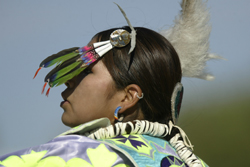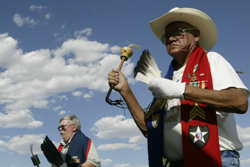|
|
Canku Ota |
|
|
(Many Paths) |
||
|
An Online Newsletter Celebrating Native America |
||
|
August 14, 2004 - Issue 119 |
||
|
|
||
|
Center Celebrates Heritage |
||
|
by Valerie Gritton - The Farmington (NM) Daily Times |
||
|
credits: photo 1: Navajo Fancy Shawl dancer Lachindah Denet, 15, of Fruitland dances Wednesday evening at the Farmington Inter-Tribal Indian Center. The center hosted an all-day celebration and morning blessing for their new hogan, which was constructed in December. ; photo 2: Vietnam veteran and Farmington resident Robert Augustine (right) participates in a gourd dance Wednesday evening at the Farmington Indian Center. (all photos by Brett Butterstein/The Farmington (NM) Daily Times |
|
The hogan was officially welcomed into the world by Navajo medicine man Francis Mitchell, who performed a traditional hogan blessing ceremony Wednesday. A hogan blessing ceremony is performed only after the last nail has been put in place and no ceremonies can be held in a hogan until it is blessed by a medicine man. Mitchell said the Navajo hogan was built when the first Navajo child, Changing Woman, was about to have her first puberty ceremony. "Since that time, the deities set that procedure that when you build a dwelling, you are supposed to anoint it," Mitchell said. During the ceremony, Mitchell used white and yellow corn meal to represent the male and female species; corn pollen was used for the spirit and for the energy of the people, animals, livestock, bird fowl and "anything else we might include with it that walks and breeds and grows," Mitchell said.
The inter-tribal organization was started by the Navajo during a time of civil unrest in Farmington. "FIIO was organized to help (Farmington) with our efforts and provide a place where Navajos can come to get information regarding the purchasing of goods and services in Farmington," said Mayor Bill Standley. "I think that we've advanced considerably in understanding and communicating with our Navajo residents and our visitors to our community." The city helped finance and build the hogan — they used funds received through a community block grant. Edward Smiley, director of the inter-tribal organization, said the hogan will be used to conduct Navajo language classes and ceremonies. Tours will also be available to the public so non-natives can get a glimpse of Navajo culture. "I think at this time and age various nationalities are being educated through different customs," Smiley said. "In this way (non-natives) will have a chance to see the hogan itself, how it's built, how it can be used and they will have a part in it." Approximately 21,000 people visit the inter-tribal organization annually. Inter-tribal President Bradley Hight said the hogan will bring a piece of Native American culture to natives who can not get home. "It is important to keep their culture alive in an urban area so they don't forget where they came from," Bradley said. "It also teaches youngsters, no matter where you go in this worked, you can have your culture. Just because you leave home doesn't mean you leave it behind." |
|
|
www.expedia.com |
|
|
||
|
|
||
| Canku Ota is a free Newsletter celebrating Native America, its traditions and accomplishments . We do not provide subscriber or visitor names to anyone. Some articles presented in Canku Ota may contain copyright material. We have received appropriate permissions for republishing any articles. Material appearing here is distributed without profit or monetary gain to those who have expressed an interest. This is in accordance with Title 17 U.S.C. Section 107. | ||
|
Canku Ota is a copyright © 2000, 2001, 2002, 2003, 2004 of Vicki Barry and Paul Barry. |
||
 |
 |
|
|
The "Canku Ota - A Newsletter Celebrating Native America" web site and its design is the |
||
|
Copyright © 1999, 2000, 2001, 2002, 2003, 2004 of Paul C. Barry. |
||
|
All Rights Reserved. |
||
 FARMINGTON
— In December a traditional Native American hogan was constructed
on a grassy knoll behind the Farmington Inter-tribal Indian Organization.
FARMINGTON
— In December a traditional Native American hogan was constructed
on a grassy knoll behind the Farmington Inter-tribal Indian Organization. Additionally,
the items were sprinkled throughout the four corners of the structure
to bring good and harmony.
Additionally,
the items were sprinkled throughout the four corners of the structure
to bring good and harmony.